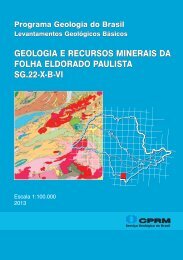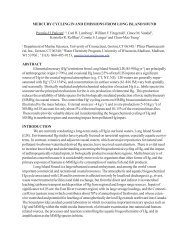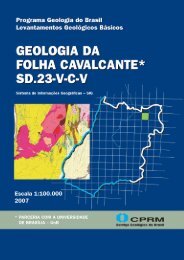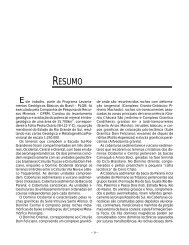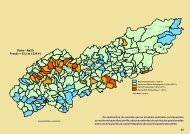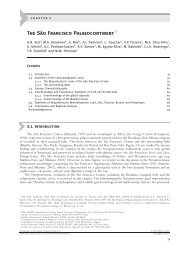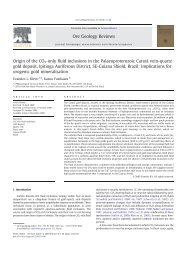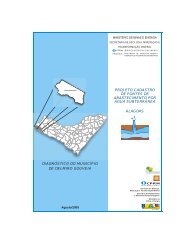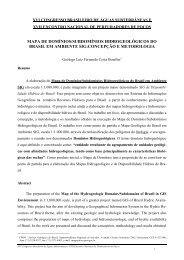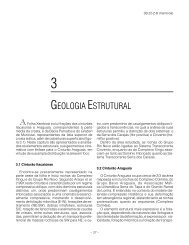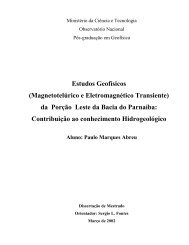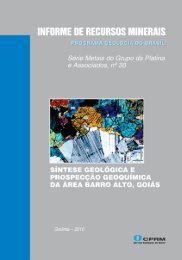Whole-rock geochemistry and Sr-Nd isotopic composition of ... - CPRM
Whole-rock geochemistry and Sr-Nd isotopic composition of ... - CPRM
Whole-rock geochemistry and Sr-Nd isotopic composition of ... - CPRM
Create successful ePaper yourself
Turn your PDF publications into a flip-book with our unique Google optimized e-Paper software.
Fig. 2. Stratigraphic chart <strong>of</strong> the Camamu Basin (modified from Caixeta et al., 2007).<br />
which comprised the area currently occupied by the Sergipe-<br />
Alagoas, Camamu <strong>and</strong> Almada basins, in the southern coast <strong>of</strong> the<br />
state <strong>of</strong> Bahia, including also the Recôncavo, Tucano <strong>and</strong> Jatobá<br />
basins <strong>and</strong> their African counterparts. Stratigraphically, the units<br />
<strong>of</strong> the pre-rift sequence <strong>of</strong> the basins <strong>of</strong> the Afro-Brazilian<br />
Depression are considered to be correlated with each other <strong>and</strong><br />
<strong>of</strong> Neojurassic age.<br />
3. Methodology<br />
3.1. Samples analyzed <strong>and</strong> analytical procedures<br />
The samples used in the present study were collected at five<br />
different outcrops in the Camamu Basin (Camamu 1, 2, 3, 4, <strong>and</strong> 5<br />
sampling sites). The sedimentary <strong>rock</strong>s exposed in these outcrops<br />
have been considered to be part <strong>of</strong> the same sedimentary unit, an<br />
assumption that will be investigated here. The precise location <strong>of</strong><br />
the sampling sites is shown in Fig. 3.<br />
It must be highlighted that due to its stratigraphic location,<br />
<strong>rock</strong>s in the Camamu 4 outcrop (Fig. 4) were considered to belong<br />
to the Aliança Formation, Capianga Member (pre-rift supersequence).<br />
However, as shown in Fig. 4, there is a local contact<br />
with sediments identified as belonging to the Sergi Formation<br />
(Fig. 2).<br />
In all outcrops, the <strong>rock</strong>s are described as reddish pelite with<br />
incipient plane-parallel lamination, locally with carbonate<br />
nodules <strong>and</strong> associated with a fluvial-lacustrine depositional<br />
environment.<br />
D.R.A. Silva et al. / Journal <strong>of</strong> South American Earth Sciences 39 (2012) 59e71 61<br />
Efforts were made to collect pelites that visually showed<br />
a smaller degree <strong>of</strong> weathering. However, the samples always<br />
showed evidence <strong>of</strong> intensive weathering processes <strong>and</strong> oxidation.<br />
Macroscopically, the samples collected at the five sampling sites are<br />
reddish argillites, locally with carbonate nodules always with the<br />
presence <strong>of</strong> white mica fragments.<br />
Approximately 500e700 g <strong>of</strong> <strong>rock</strong> were collected from each<br />
sampling site. Care was taken not to contaminate the samples<br />
with fragments from other units; carbonate nodules were<br />
rejected. A minimum <strong>of</strong> four samples was collected at each<br />
outcrop, always maintaining a minimum distance <strong>of</strong> 1 m<br />
horizontally between each sample, according to the methodology<br />
described by Thomaz Filho <strong>and</strong> Lima (1979).<br />
The samples were crushed in an agate mortar <strong>and</strong> dried at<br />



